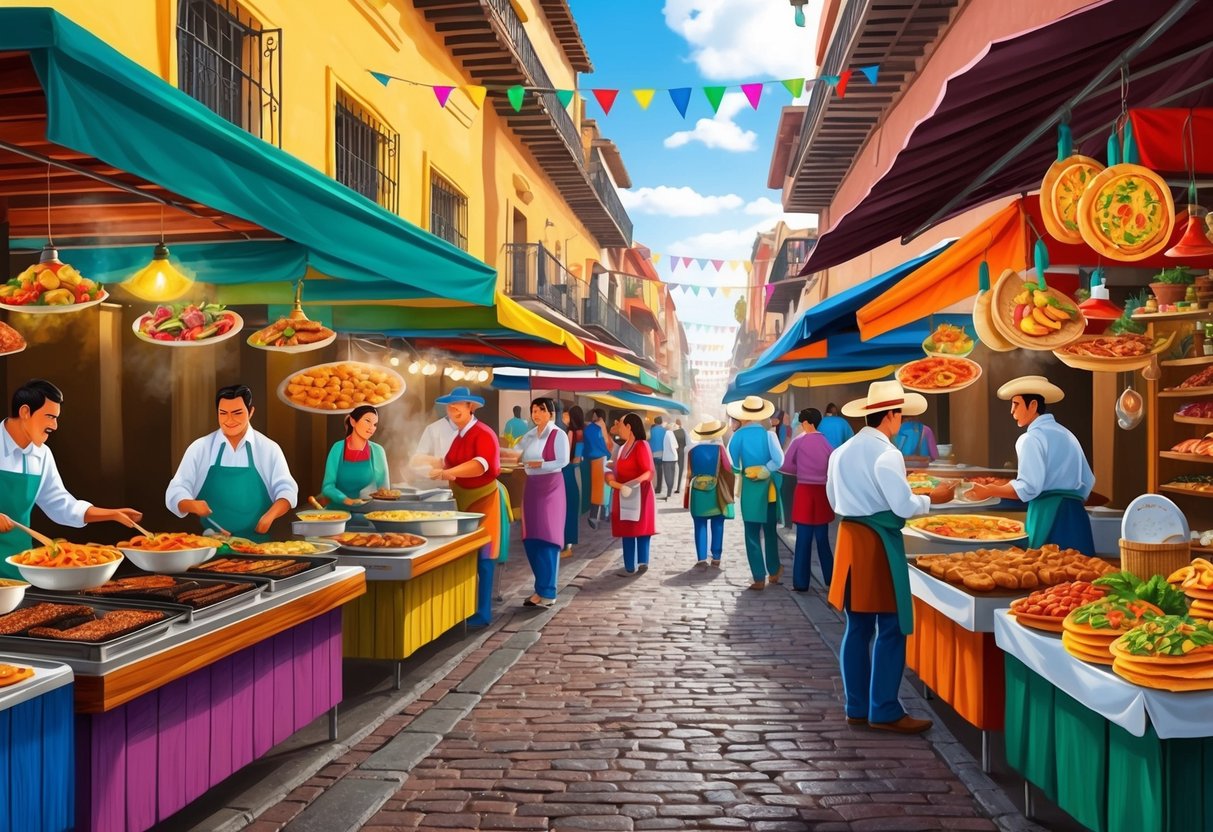
Regional Flavors: Exploring Oaxaca, Puebla, Yucatán, and Veracruz

Mexico’s rich regional diversity is reflected in distinct street foods, cooking styles, and signature ingredients shaped by local history and geography. Key destinations like Oaxaca, Puebla, Yucatán, and Veracruz showcase vibrant flavors, each offering a unique glimpse into authentic Mexican cuisine.
Oaxacan Specialties
Oaxaca is celebrated for its deep culinary heritage, famed local ingredients, and variety of traditional moles. Street vendors often serve tlayudas—large, crisp tortillas topped with refried beans, Oaxacan cheese, lettuce, tomato, avocado, and grilled meats.
The state is renowned for its seven classic moles, including mole negro and mole coloradito. These sauces blend chilies, spices, seeds, nuts, and sometimes chocolate, creating layered flavors.
Simple snacks like chapulines (grasshoppers) seasoned with lime and chili are sold by street vendors and considered a crunchy treat with a tangy, savory kick. Oaxaca’s cheese, known as quesillo, is a key ingredient in many dishes.
Its stringy texture and mild flavor are perfect for empanadas, quesadillas, and tlayudas. Oaxacan cuisine is also known for its use of indigenous herbs like epazote and hoja santa, adding earthy notes to everyday street fare.
Puebla’s Street Food
Puebla stands out for its use of aromatic spices and melding of indigenous ingredients with European traditions. Mole poblano is a key specialty, featuring a complex sauce combining dried chilies, chocolate, nuts, and spices, typically served over chicken or turkey.
Street vendors in Puebla are famed for cemitas poblanas, a sesame-seed sandwich roll stuffed with fried cutlets, stringy cheese, avocado, papalo herb, and salsa.
Another favorite is chalupas, small tortillas fried in lard, then topped with shredded meat, onions, red or green salsa, and sometimes potatoes.
For a light bite, molotes—oval-shaped masa dough pockets filled with potatoes, chorizo, or cheese—are a popular choice.
Puebla’s sweet tooth is satisfied by treats such as camotes, a soft, sweet potato candy flavored with fruit and often sold at street stalls.
Yucatán’s Unique Dishes
Yucatán is known for its bold seasoning and the influence of Mayan, Spanish, and Caribbean cultures.
The region’s street foods center around citrus, achiote, and habanero peppers, providing bright, aromatic flavors.
Cochinita pibil is an essential dish: slow-roasted pork marinated in achiote and sour orange, typically served in tacos or on tortas.
Other common street offerings include salbutes and panuchos—both are fried tortillas topped with shredded turkey or chicken, lettuce, tomato, pickled red onions, and avocado.
Panuchos differ by having a layer of refried black beans in the tortilla.
Papadzules—egg-filled tortillas topped with pumpkin seed sauce and tomato—showcase Yucatán’s love for hearty, protein-rich snacks.
The region’s hot climate also favors cooling, tropical drinks made from local fruits like sour orange, tamarind, or chaya.
Coastal Veracruz Flavors
Veracruz’s street food celebrates its coastal bounty and Afro-Caribbean influences.
Seafood is central to local snacks, with staples such as empanadas de mariscos and tacos filled with fried fish or shrimp frequently available along the waterfront.
Vuelve a la vida is a zesty seafood cocktail with shrimp, octopus, and oysters, dressed in lime juice, tomato, onion, and fresh chilies.
Picadas—thick corn tortillas with crimped edges—are topped with salsa, cheese, and sometimes shredded beef or eggs, making them a popular breakfast or snack food.
Local dishes are enhanced by native herbs and tropical ingredients.
For instance, the use of plantains, coconut, and fresh salsa Veracruzana (with tomato, olives, and capers) reflects the region’s maritime character.
Local drinks often feature flavors such as vanilla, which is indigenous to Veracruz and used in desserts and coffee.
Popular Snacks and Small Bites

Authentic Mexican street food offers a mix of deep flavors, traditional ingredients, and a creative use of local produce.
These classics are recognized for their rich history and widespread popularity at food stalls across Mexico.
Pozole
Pozole is a celebrated Mexican soup, often enjoyed at festive gatherings or on special occasions.
This hearty dish is made from hominy corn simmered with meat, usually pork or chicken, and a blend of chilies and garlic.
The broth varies by region, with three main types—rojo (red), verde (green), and blanco (white)—each featuring different chili blends and seasonings.
Customarily, pozole is served with an array of toppings, including shredded lettuce or cabbage, thinly sliced radishes, diced onions, fresh lime wedges, and dried oregano.
While it’s a complete meal on its own, it is also a popular street snack, especially during festivals.
Recipes for authentic pozole carefully follow family traditions and are cherished in many Mexican households.
Chicharrón
Chicharrón is the Spanish term for fried pork rinds, though in Mexico, it can also refer to crunchy fried chicken or fish skin.
It is a staple snack at many street food vendors, praised for its crispy texture and savory taste.
The best chicharrón is light, airy, and full of flavor, making it a favorite with locals.
It is often enjoyed on its own, sprinkled with chili powder, or used as a filling in tacos, quesadillas, and tortas.
When served fresh and hot, chicharrón has a distinct crunch that pairs perfectly with a dash of hot sauce and a squeeze of lime.
Its versatility as a snack or an ingredient in various Mexican dishes makes it an essential part of Mexican street cuisine.
Mexican Chili Dishes
Chili is central to Mexican cuisine, appearing in countless street food snacks and small plates.
Classic options include chili-laden esquites (corn kernels sautéed with chilies and lime), spicy taquitos topped with salsa, and enchiladas bathed in bold chili sauces.
These dishes showcase both the heat and the complex earthy, smoky notes of fresh and dried chilies.
Different varieties of Mexican chili, such as jalapeño, poblano, and guajillo, offer a spectrum of flavors from mild and slightly sweet to intensely spicy.
Street vendors often highlight their signature salsas and chili mixes, giving each plate a unique flair.
To explore these dishes is to experience the heart of Mexican street food and the spice-driven creativity that defines it.



